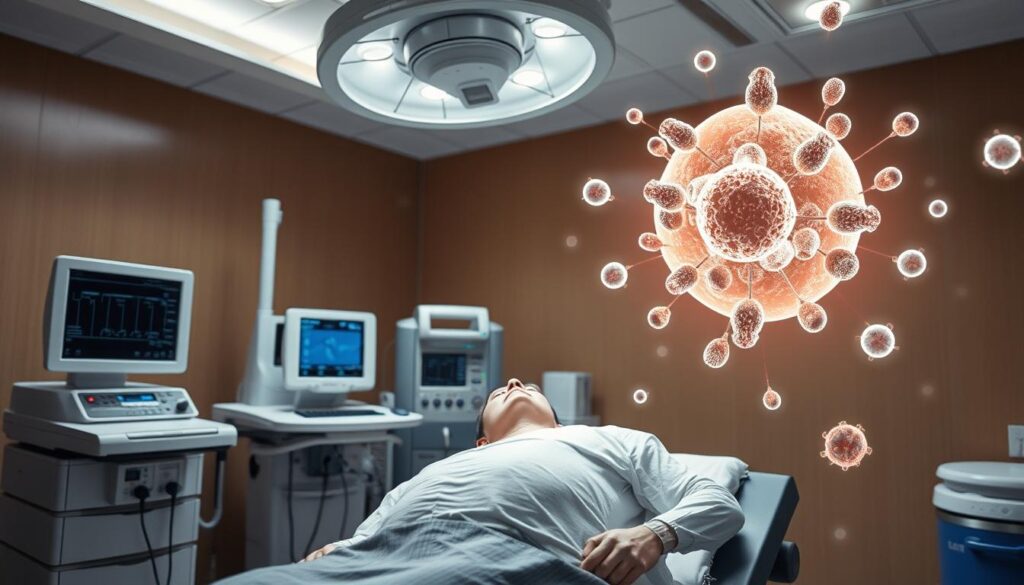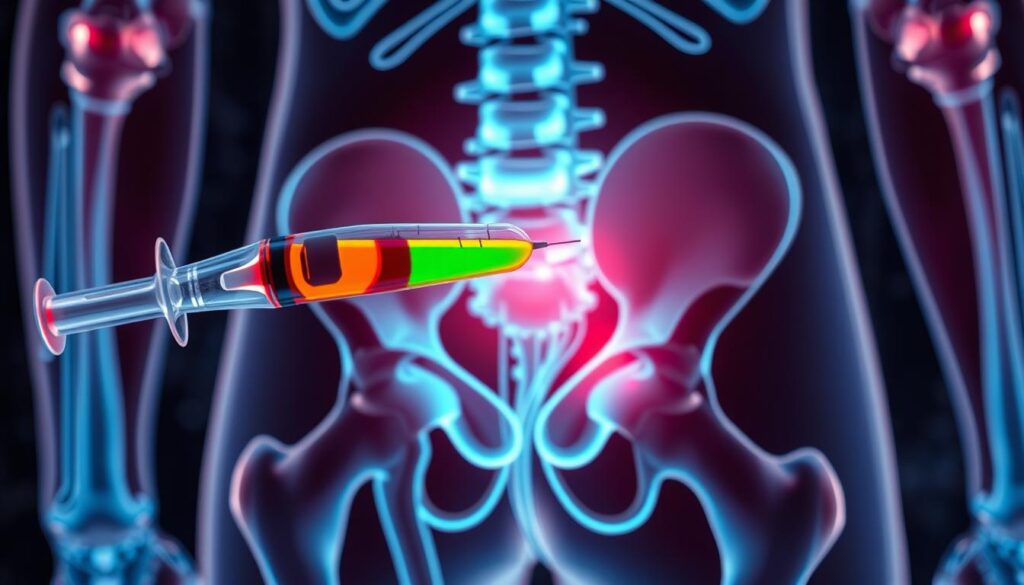Did you know that nearly 40% of people with chronic hip pain don’t get much help from usual treatments? This has led many to look into new ways to heal, like stem cell therapy. It uses your body’s own healing powers to fix the pain’s source.
With more cases of sciatica due to degenerative disc diseases and lifestyle issues like obesity, we need new ways to manage it. Unlike common exercises for sciatica hip pain, stem cell therapy might offer a better solution. It not only eases symptoms but also fixes the problem, possibly improving your life quality. Contact us to find out how stem cell therapy can help your pain1.
Key Takeaways
- Nearly 40% of chronic hip pain sufferers find limited relief from traditional treatments.
- Stem cell therapy can tackle the root causes of pain more effectively than conventional exercises.
- Innovative pain solutions like stem cell therapy offer the potential for lasting recovery.
- Chronic pain affects approximately 30% of patients in developed countries.
- Stem cells have the ability to transform into various cell types, aiding in pain management.
Understanding Sciatica: Causes and Symptoms
Sciatica affects the sciatic nerve, running from the lower spine to the legs. It can be caused by herniated disks and spinal stenosis. Knowing the common symptoms and how sciatica impacts daily life is key.
What is Sciatica?
Sciatica usually hits one side of the lower body, causing pain that can be severe or just annoying2. People between 20 and 50 often get herniated disks, which lead to sciatica3. Other issues like spinal stenosis and degenerative disk disease can also make sciatica worse2.
Common Symptoms of Sciatica
Sciatica can cause burning, sharp pain, and numbness. If symptoms are severe, seek medical help right away. Using cold and hot packs, stretching, and low-impact exercises can help2. Most people see improvement in 4 to 6 weeks, often without needing a doctor3.
Impact of Sciatica on Daily Life
Sciatica can greatly affect your daily activities, work, and hobbies. It can make simple tasks hard due to pain. Factors like age, obesity, and sitting too long can make sciatica worse3.
Keeping good posture, exercising, and strengthening core muscles can help. This can reduce the chance of sciatica coming back3.
Traditional Treatments for Sciatica
Many people with sciatica try traditional therapies for relief. These methods can help but also have their own problems and risks.
Overview of Conventional Approaches
Common treatments include medicines, physical therapy, and sometimes surgery. Most people with sciatica get better in a few weeks, showing these methods work4. It’s suggested to start gentle exercises soon after the pain starts, doing them at least twice a week4.
Physical therapists offer various therapies like hot and cold packs, massage, TENS, and hydrotherapy. These can help reduce pain4.
Limitations of Traditional Treatments
Despite their benefits, traditional therapies have their limits. Some people don’t find much relief, especially if pain lasts over four months4. Being inactive for too long can make sciatica worse, showing the need for a balanced treatment5.
Risks and Side Effects Associated with Surgery
Surgery is usually a last choice, used for severe cases or when other treatments fail5. However, it can lead to nerve damage and long recovery times, making many hesitant5. Also, treatments like acupuncture have mixed results, leaving patients unsure5.
Why Exercises for Sciatica Hip Pain May Not Be Enough
When you have sciatic nerve pain, you might try exercises to help. But these exercises might not fix the real problem. Sciatica usually hits one side of your body. Activities that make it worse can cause more pain and irritation6.
Many treatments just focus on the symptoms. They don’t always give the relief people need.
Effectiveness of Exercises Compared to Other Treatments
How well exercises work for sciatica can vary. Some movements might help soft tissue heal, but they don’t solve the main pain issues. For example, squats can put more pressure on your lower back6.
People with severe pain might need to avoid hard activities. Physical therapist Brian Jones says a better approach includes gentle movements and structured rehab7.
The Role of Rehabilitation in Sciatica Treatment
Rehab is key in treating sciatica. It focuses on managing pain and improving flexibility and posture6. A good rehab plan can really help you move better.
For long-term pain, seeing a physical therapist is a good idea. They can make a treatment plan just for you7. This shows that just doing exercises might not be enough to fix sciatica.
The Advantages of Stem Cell Therapy

Stem cell therapy uses your body’s healing powers to fix damaged tissues. It’s great for managing pain, especially sciatica. It works by fixing tissues and reducing inflammation.
What is Stem Cell Therapy?
This therapy uses cells from your body to help heal. Studies show it can fix sciatica by repairing tissues and easing nerve pressure8. In 2017, Dr. Wenchun Qu’s research found it greatly helped patients with pain and function9.
How Stem Cells Aid in Pain Management
Stem cells offer a new way to manage pain by fixing specific problems like herniated discs. They create personalized treatment plans for better results. Research is improving how to deliver stem cells for better healing8.
This method not only fixes tissues but also heals nerves and discs in the spine. This leads to less pain and better movement8.
Comparison with Traditional Treatment Approaches
Stem cell therapy is a non-surgical option with quick recovery times. It tackles the root causes of pain, unlike traditional treatments. Studies show it offers lasting relief for chronic pain9.
| Treatment Type | Recovery Time | Target Areas | Effectiveness |
|---|---|---|---|
| Traditional Treatments | Variable | Muscle, nerve, joints | Often limited |
| Stem Cell Therapy | Short | Spine, joints, nerves | Promising results |
Stem cell therapy is a healing-focused option. For more on personalized treatments and stem cell benefits, contact us to learn more89.
Stem Cell Therapy Technology Explained
Stem cell technology is key in treating sciatica. It offers insights into how healing works. Knowing about the types of stem cells, how they work, and ongoing studies helps understand this new approach.
Types of Stem Cells Used in Therapy
Stem cell therapy uses different types of stem cells, like mesenchymal stem cells (MSCs). MSCs come from bone marrow and fat tissue. They help repair damaged tissues, which is crucial for sciatica treatment.
Mechanism of Action in Treating Sciatica
Stem cell therapy works by making new cells that help fix damaged tissues. Research shows MSC therapy can improve nerve functions and speed up healing10. This helps reduce pain and improve life quality for sciatica patients11.
Current Research and Clinical Studies
Studies on stem cells show promising results for sciatica and other conditions. Treatments have a 50% to 70% success rate in managing pain12. Researchers are working to make treatments better and reduce risks12. Early results suggest stem cell therapy can lead to better function and faster recovery than traditional methods11.
How Stem Cell Injections Work for Sciatica Pain Relief

Stem cell injections are a new way to fight sciatica pain. They send special cells right to the pain spot. This method is less invasive and can help with pain relief and better movement.
The Process of Stem Cell Injection
Doctors put mesenchymal stem cells into the painful area. These cells come from bone marrow or fat. They help reduce swelling and heal the area.
This method is becoming popular because it doesn’t take long to recover. It’s faster than traditional surgery13.
Expected Outcomes from Treatment
People often see big improvements after getting stem cell injections. Studies show these treatments work well, with about 40.7% success for lower back pain after six months14. The benefits of stem cell injections go beyond just quick relief. They can also help joints work better and improve movement.
Patient Recovery and Follow-up
It’s important to check in after treatment to see how you’re doing. You can usually go back to normal activities quickly after the injection. This means you can get back to your daily life fast13.
Regular check-ups help make sure you’re healing well. This way, any problems can be fixed quickly. It makes the recovery process smooth and supportive.
Innovative Pain Solutions Beyond Exercises
Traditional exercises are often suggested for sciatica. But, there are many new ways to find relief. Learning about these options can help you choose the best treatment for you.
Alternative Therapies: What Are Your Options?
Alternative therapies are getting more attention for sciatica. Acupuncture is one, offering relief after 6-12 sessions15. Pulsed radiofrequency is another, stopping pain signals without surgery16. TENS is also helpful, easing pain without drugs.
Minimally Invasive Procedures for Pain Reduction
Less invasive methods are becoming popular. Epidural steroid injections can reduce nerve inflammation17. Laser therapy is also promising, offering targeted pain relief in therapy.
Exploring alternative therapies and minimally invasive procedures can improve your pain management. Think about these options before going for surgery. Talk to your doctor for advice. Stem cell technology might be the answer—contact us to find out more161715.
Real-Life Success Stories: Patients Who Chose Stem Cell Therapy
Many people have found relief from sciatica pain through stem cell therapy. They share their stories, showing how much better they feel after treatment.
Case Studies on Sciatica Treatment
Studies show great results for those with sciatica. For example, a person with spinal arthritis was pain-free for the first time in years, ten months after treatment18. Others can now play tennis without pain after stem cell therapy18.
These cases highlight the chance for better mobility and life quality after treatment.
Patient Testimonials and Recovery Experiences
Patients share their journeys of healing. Robyn Davis is proud of her shoulder treatment, and Jim Seely is happy with his knee treatment19. Henry Martin and Bruce Moline also found relief from their nerve and knee pain19.
These stories show the success of stem cell therapy. Many people have less pain and better function after PRP injections18. If you’re looking for a healing path, these stories might inspire you.
These testimonials are not just proof but also encouragement. They help make stem cell therapy more accepted for chronic pain. These stories can help you decide if it’s right for you.
Best Remedy is Stem cell Technology – Contact Us to Learn more.
| Patient | Treatment | Outcome |
|---|---|---|
| Robyn Davis | Shoulder Treatment | Successful Recovery |
| Jim Seely | Knee Treatment | Positive Results |
| Henry Martin | Nerve Pain Treatment | Experienced Relief |
| Bruce Moline | Knee Treatment | Successful Outcome |
| Patient A | Stem Cell Therapy | Pain-Free Activity |
These examples show how stem cell therapies can change lives by reducing chronic pain and improving quality of life.
Future of Chronic Pain Management: Regenerative Medicine
Regenerative medicine is changing how we manage chronic pain. It uses the body’s own healing powers. This is especially true for sciatica and other musculoskeletal issues. It’s a new way to help people feel better.
Potential of Stem Cells in Treating Other Conditions
Stem cell therapy is a big hope for chronic pain treatment. It helps fix damaged tissues and lowers pain. For example, PRP therapy uses the patient’s own blood to help sciatica20.
Stem cells also help with degenerative disc disease and herniated discs20.
What’s Next for Stem Cell Research and Technology?
Studying stem cells is key to better pain management. Researchers are looking at different types of stem cells. They want to see how they can help fix damaged discs21.
This research could lead to new, non-surgical ways to treat pain. It could make treatments more precise and effective.
Seeing a specialist in regenerative medicine could change your life. It combines new tech with innovative treatments. This could lead to lasting relief and a better quality of life.
If you’re looking for ways to manage pain, stem cell technology might be the answer. Contact us to find out how regenerative medicine can help you2021.
Conclusion
Stem cell therapy is a promising option for those looking for effective sciatica treatment. It uses advanced technology to help your body heal itself. Studies show that over 90% of patients see less pain and better function, proving it’s a viable alternative22.
Research keeps growing, showing stem cell therapy’s potential in treating chronic pain. It’s different from traditional exercises that might make pain worse. This treatment aims to fix the problem at its source, helping you recover and regain your independence23.
If you’re looking for a new way to manage your sciatica, stem cell technology might be the answer. Don’t wait to learn more or talk about how it could help you. Your journey to feeling better could start with just one conversation24.
FAQ
What is stem cell therapy for sciatica?
Stem cell therapy uses special cells to fix damaged tissues. It helps with sciatica by healing and reducing inflammation. This method aims to ease pain at its source.
How does stem cell therapy compare to traditional exercises for sciatica hip pain?
Traditional exercises help with temporary relief, but stem cell therapy goes deeper. It regenerates tissues, offering a lasting solution for chronic pain.
Are stem cell injections painful?
Stem cell injections are done with local anesthesia. Most people feel a bit of discomfort but it’s usually manageable.
How long does it take to see results from stem cell therapy?
Many see improvements in pain and movement within weeks to months. Recovery times can differ based on the condition and health.
What are the risks associated with stem cell therapy?
It’s generally safe, but risks include infection, allergic reactions, or mild pain at the site. Always talk to your doctor about any worries.
Can stem cell therapy be combined with other treatments for sciatica?
Yes, it can be used with physical therapy, alternative therapies, or pain management. This combination can improve recovery and results.
Is there ongoing research into stem cell therapy for sciatica?
Yes, studies are ongoing to see how well it works for sciatica and other conditions. The results look promising for pain relief and recovery.
What alternative therapies are available for sciatica pain relief?
Besides stem cell therapy, options include acupuncture, pulsed radiofrequency, and transcutaneous electrical nerve stimulation. These are non-surgical methods for sciatica and hip pain relief.
Source Links
- Get the best treatment for Sciatica with stem cells in 2024
- Symptoms and Causes of Sciatica
- Sciatica – Symptoms and causes
- Sciatica: Exercises for Pain Relief
- Sciatica – Diagnosis and treatment
- 10 Sciatica Exercises to Avoid
- Stretches and Exercises to Ease Sciatica Pain, from a PT
- Stem Cell Treatments for Sciatica-Related Back Pain
- How Can Stem Cell Treatment Help With Back Pain? – SpineINA
- “Stem cell therapy to promote limb function recovery in peripheral nerve damage in a rat model” – Experimental research
- Stem Cell Therapy: How Does It Work and What Does It Treat?
- Stem Cell Therapy – SpinePain Solutions
- Can Stem Cell Therapy Help with Sciatica?
- Stem Cell Therapy for Pain Relief: What You Need to Know?
- 9 Effective Sciatica Treatments – Complete Treatment Guide
- Immediate Relief for Sciatica Pain
- Putting An End to Your Hip and Knee Pain Naturally
- Testimonials | Michigan Center for Regenerative Medicine
- iOBX real patients testimonials | Treatments | Cary,NC
- The Role of Regenerative Medicine in Treating Sciatica
- Regenerative medicine for the treatment of chronic low back pain: a narrative review
- Sciatica – Small Steps, Big Changes to a Pain in the Butt – Part 4
- How effective are physiotherapy interventions in treating people with sciatica? A systematic review and meta-analysis
- Sciatica Stretches to Heal Your Pain | Princeton Orthopaedics



